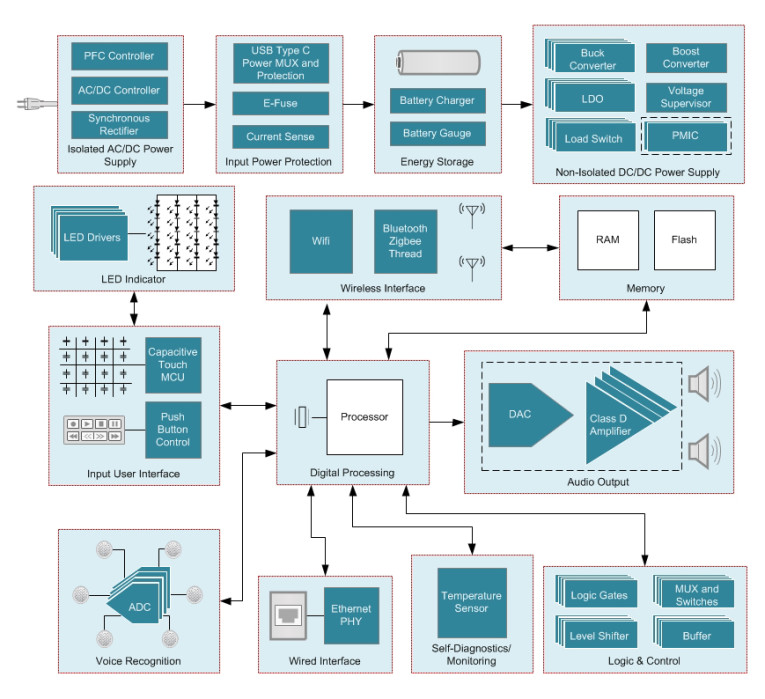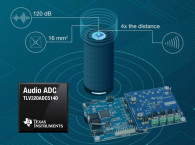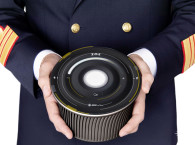
Overall System Costs
Reducing system cost is a priority for the entire smart home industry. In the smart speaker space, the greatest opportunity for designers to potentially reduce system cost is in the selection of the audio amplifier. Instead of trading audio performance for cost savings, Texas Instruments’ (TI) audio team developed solutions to reduce the system cost around the amplifier while improving performance.
For audio systems under 10 W per channel, for example, TI’s electromagnetic interference suppression technology enables the use of ferrite beads instead of inductors. Given that the average cost of four inductors is $0.16 and the average cost of four ferrite beads is $0.04, designers could save an average of $0.12 in a two-channel system with this feature alone.
Battery Runtime and Thermal Considerations
Small battery size makes smart speakers smaller, lighter, and portable. Higher efficiency and better thermal considerations help reduce battery size while retaining battery runtime. However, there is a constant power draw from the microphones and system-on-a-chip (SoC), which are listening for the next instruction. Thus, designers must look for other areas where they can decrease standby power and thermal dissipation.
One of the best places to start is the audio amplifier because it has the highest standby power draw and highest thermal dissipation apart from the SoC. To reduce standby power, audio amplifiers with multiple modulation modes can change the duty cycle of the output pulse width modulation (PWM) to control the current flow from the inductor to the speaker, reducing idle current up to 50%. This will reduce the overall power draw and improve thermal dissipation, allowing for longer battery runtime without increasing battery size.

Acoustic Echo Cancellation
Accurate speech recognition is a defining feature of a smart speaker, affecting the performance of the virtual assistant (VA). One of the challenges is that the microphones pick up all types of background noise in the environment, including other appliances, people talking, and even the music the smart speaker is playing. To filter out background noise and recognize user voice commands, smart speakers should have more than one microphone and employ complex techniques for accurate speech recognition.
One of those techniques is acoustic echo cancellation (AEC), which takes the digital signal of the music being played and subtracts that signal from the input of the microphone. AEC digitally cancels all background noise, including the music. To better filter out background noise, audio amplifiers specifically designed for AEC have a post-processed SDOUT signal. As shown in Figure 1, the SDOUT is fed to the SoC in a way that filters out the music signal the microphones are receiving.
Premium Audio Quality
Smart speaker designs are small and attractive. But with a smaller speaker size, there is less audio output power. Amplifiers with robust speaker protection can achieve bigger sound from a speaker without damaging it. By using algorithms and models, speaker protection amplifiers analyze the incoming music signal, then deliver peak output power up to five times the nominal speaker rating, resulting in an output that is two to three times louder, without changing the speaker. This means that even a small smart speaker can sound bigger than it looks.

What’s Next?
Achieving high-fidelity sound is one of the smart speaker market’s top priorities, as is the convergence of interactive voice response with traditional speakers. Although most Bluetooth speakers on the market today have no speech recognition or interactive voice-response functionality, it will become a de facto requirement.
Battery-powered smart speakers will need to meet the same power demands as line-powered speakers. This will be the next opportunity for smart speaker designs. Over the past 10 years, as speaker design trends have shifted from larger residential applications to smaller, portable personal applications, TI has provided the technology and systems expertise to support these designs. Figure 2 shows TI’s smart speaker system block diagram.
To view an interactive version of this block diagram, or to browse more reference designs, application notes and other resources addressing smart speaker design challenges, visit www.ti.com/smartspeaker. aX
Resources
See these TI reference designs for smart speaker systems at www.ti.com/smartspeaker.
o Less than 90mW Ultra-Low Standby Power Auxless AC/DC Power Supply Reference Design.
o 12mm x 12mm, 5-Rail Power Sequencing for Application Processors Reference Design.
o Human Machine Interface with LED Animation Reference Design.
o MSP432™ MCU with MSP430™ Capacitive Touch MCU, Haptics and LCD Reference Design.
o PCM1864-Based Circular Microphone Board (CMB) Reference Design.
o Ultra-Mobile, Low Power nHD Display Reference Design with TI DLP® Technology for Low-Cost Processors.
This article was originally published in audioxpress, December 2018.





